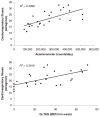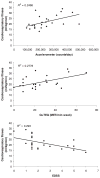Physical inactivity, neurological disability, and cardiorespiratory fitness in multiple sclerosis
- PMID: 21108624
- PMCID: PMC3148147
- DOI: 10.1111/j.1600-0404.2010.01361.x
Physical inactivity, neurological disability, and cardiorespiratory fitness in multiple sclerosis
Abstract
Objective: We examined the associations among physical activity, neurological disability, and cardiorespiratory fitness in two studies of individuals with multiple sclerosis (MS).
Method: Study 1 included 25 women with relapsing-remitting MS (RRMS) who undertook an incremental exercise test for measuring peak oxygen (VO₂(peak) ) consumption, wore an accelerometer during a 7-day period, and completed the Godin Leisure-Time Exercise Questionnaire (GLTEQ). Study 2 was a follow-up of Study 1 and included 24 women with RRMS who completed the self-reported Expanded Disability Status Scale (EDSS), undertook an incremental exercise test, wore an accelerometer during a 7-day period, and completed the GLTEQ.
Results: Study 1 indicated that VO₂(peak) was significantly correlated with accelerometer counts (pr = 0.69) and GLTEQ scores (pr = 0.63) even after controlling for age and MS duration. Study 2 indicated that VO₂(peak) was significantly correlated with accelerometer counts (pr = 0.50), GLTEQ scores (pr = 0.59), and EDSS scores (pr = -0.43) even after controlling for age and MS duration; there was a moderate partial correlation between accelerometer counts and EDSS scores (pr = -0.43). Multiple linear regression analysis indicated that both accelerometer counts (β = 0.32) and EDSS scores (β = -0.40) had statistically significant associations with VO₂(peak).
Conclusion: The findings indicate that physical inactivity and neurological disability might represent independent risk factors for reduced levels of cardiorespiratory fitness in this population.
© 2010 John Wiley & Sons A/S.
Figures


References
-
- Durstine JL, Painter P, Franklin BA, Morgan D, Pitetti KH, Roberts SO. Physical activity for the chronically ill and disabled. Sports Med. 2000;30:207–19. - PubMed
-
- Åstrand RO, Rodahl K. Textbook of work physiology. New York, NY: McGraw-Hill; 1977.
-
- Brooks GA, Fahey TD, White TP. Exercise physiology: human bioenergetics and its applications, 2nd edn. Mountain View, CA: Mayfield Publishing Company; 1996.
-
- Ponichtera-Mulcare JA. Exercise and multiple sclerosis. Med Sci Sports Exerc. 1983;25:451–65. - PubMed
-
- Motl RW. Physical activity and its measurement and determinants in multiple sclerosis. Minerva Med. 2008;99:157–65. - PubMed
Publication types
MeSH terms
Grants and funding
LinkOut - more resources
Full Text Sources
Medical
Research Materials

